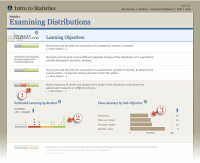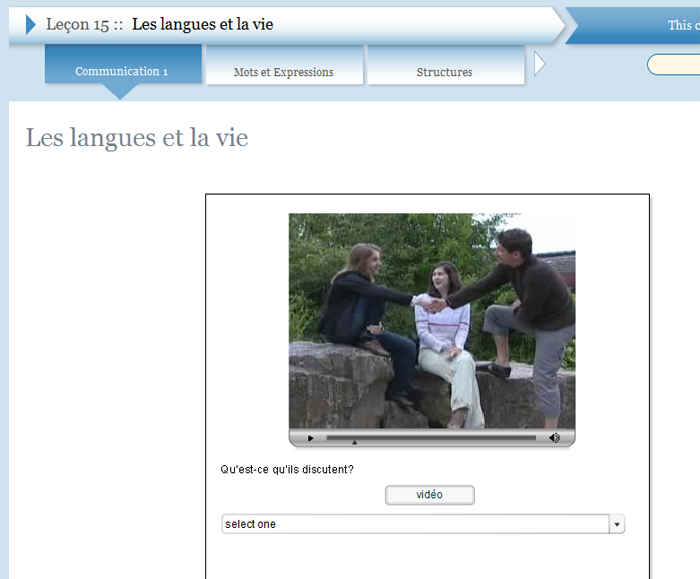Learn how to communicate with the sounds and music of American English. Improve your pronunciation in Standard American English by dealing with the sounds of the words that you speak. NOTE: This is a course on speaking American English, not learning the English language.
American English Speech
$25
- Description
- What students will learn
- Learning objectives by module
- Course assessments, activities, and outline
- Other course details
- System requirements
- Included instructor tools
Description
This course will be beneficial if you wish to learn how to communicate with the sounds and music of American English. The purpose is not to increase your vocabulary, nor to improve your grammar, but to deal with the sounds of the words that you speak. Your message is of primary importance, but it may not be understood if your pronunciation is imprecise, inconsistent, or regional. This course is particularly useful for actors or for others who need to speak to diverse audiences, such as when giving a business presentation.
You will have the flexibility of time to experience, at your own pace, aural and visual aspects of a sound. Within the course, students are assessed on their ability to recognize each sound in a variety of contexts and are given feedback on their particular answers.
In-Depth Description
In the context of effective speech, “Standard American” refers to a single standard, devoid of regional influences. Few people in the U.S. grow up speaking Standard American English Dialect; geography plays a major role in the way people speak. An accent or a dialect that could interfere with a clear exchange of ideas with those using a differing dialect or accent.
It is true that there is no official standard, but there is an understood range of acceptability for American English. As a professor of speech for actors, Baker-Shirer aims to teach a manner of speech that communicates the content of words with clarity and consistency.
“Standard American” is not a judgment of value; none of the numerous American dialects is superior to the others. Instead it is a standard for clear, consistent speech recognizable to listeners across dialects. It does not burden the listener with the extra cognitive load of filtering out regional differences before reaching the meaning or intent of the speaker. Speaking Standard American dialect means speaking English that will sound American—simple, unaffected and distinct, devoid of regional influences.
This course is divided into five sections or units:
- Foundations of Speech
- This first unit of the course is an overview of some of the basic concepts that will lay a foundation for your study of the Standard American English dialect. These concepts include sound identification, voiced and voiceless sounds, syllabification, and aspiration and unaspiration of the three stop-plosive consonant groups.
- Intonational Patterning of American English
- The next unit of this course attends to the music of Standard American English Dialect and is most essential to support and increase meaning. The techniques involved in successful vocal dynamics include: vocal range, tempo, pacing, inflection and pausing.
- Vowels
- The vowels unit will introduce you to the pure vowel sounds of the dialect. As the tone carriers, vowels are an important part of your speech, and there is a great deal of subtlety between some of these sounds. Here we will introduce you to the fifteen vowel sounds of the dialect in three categories, front, mid, and back vowels.
- Diphthongs
- This unit will build on what you learned in the vowels unit by introducing the ten diphthongs of the dialect. In the Standard American English Dialect there are five so-called long diphthongs and five always short diphthongs of r.
- Weak Forms
- The weak forms unit will introduce you to the concept of stress in speech. More specifically, weak forms of certain words in the English language exist to increase clarity and understanding while subordinating the inessential. The following parts of speech are usually weakened in continuous speech: articles, conjunctions, auxiliary verbs, personal pronouns and prepositions.
What students will learn
You will learn to:
- Articulate sounds and words using the dialect of Standard American English.
- Listen and think in terms of symbols for sounds, using the International Phonetic Alphabet.
- Use the International Phonetic Alphabet to transcribe from the Roman alphabet into the forty-four sounds of Standard American Dialect and vice versa.
- Analyze texts for phrasing, operative words, intonational patterns, degrees of stress.
- Achieve a proper use of weak forms for certain parts of speech in the English Language, making your speech clear and efficient.
Learning objectives by module
Unit 1: American English Speech
- Module 1 Succeeding in American English Speech
- Assess your skills (in recognizing various sounds, sound production, integrating material into speech patterns) relative tostated objectives.
- Recognize appropriate study strategies in particular situations.
- Use the OLI learning environment effectively to support your learning.
Unit 2: Basics
- Module 2 Introduction to the Basics
- Articulate the aspiration and unaspiration of the three stop-plosive consonants.
- Articulate the voiced and voiceless consonants.
- Identify individual sounds within a word.
- Recognize when a consonant is voiced or unvoiced.
- Use the guidelines for syllabification to correctly divide words.
- Module 3 Foundation in Sounds
- Articulate the aspiration and unaspiration of the three stop-plosive consonants.
- Articulate the voiced and voiceless consonants.
- Identify individual sounds within a word.
- Recognize when a consonant is voiced or unvoiced.
- Use the guidelines for syllabification to correctly divide words.
Unit 3: American English Intonation
- Module 4 Music of Speech
- Discriminate between the four degrees of stress in American English Speech patterns.
- Increase ability to identify the melody of American English Speech.
Unit 4: Vowels
- Module 6 Introduction to Vowels
- Differentiate between vowel sounds.
- Position lips, jaw and tongue to create various vowel sounds.
- Use the vowel quadralateral to guide sound production.
- Module 7 Front Vowels
- Demonstrate proper pronunciation of each vowel.
- For the five long vowels, articulate the general rules for vowel length.
- Match the correct phonetic symbol with its corresponding sound.
- Recognize and avoid common errors in the pronunciation of each vowel.
- Module 8 Back Vowels
- Demonstrate proper pronunciation of each vowel.
- For the five long vowels, articulate the general rules for vowel length.
- Match the correct phonetic symbol with its corresponding sound.
- Recognize and avoid common errors in the pronunciation of each vowel.
- Module 9 Mid Vowels
- Demonstrate proper pronunciation of each vowel.
- For the five long vowels, articulate the general rules for vowel length.
- Match the correct phonetic symbol with its corresponding sound.
- Recognize and avoid common errors in the pronunciation of each vowel.
Unit 5: Diphthongs
- Module 10 The So-Called Long Diphthongs
- Articulate the general rules for diphthong length.
- Demonstrate proper pronunciation of each diphthong.
- Match the correct phonetic symbol with its corresponding sound.
- Recognize and avoid common errors in the pronunciation of each diphthong.
- Module 11 The Always Diphthongs
- Demonstrate proper pronunciation of ɑə̆.
- Demonstrate proper pronunciation of each vowel.
- Demonstrate proper pronunciation of ɛə̆.
- Demonstrate proper pronunciation of ɪə̆.
- Demonstrate proper pronunciation of ɔə̆.
- Demonstrate proper pronunciation of ʊə̆.
- Match ɑə̆ with its corresponding sound.
- Match ɔə̆ with its corresponding sound.
- Match the correct phonetic symbol ɛə̆ with its corresponding sound.
- Match the correct phonetic symbol with its corresponding sound.
- Match ʊə̆ with its corresponding sound.
- Recognize and avoid common errors in the pronunciation of ɑə̆.
- Recognize and avoid common errors in the pronunciation of each diphthong.
- Recognize and avoid common errors in the pronunciation of ɛə̆.
- Recognize and avoid common errors in the pronunciation of ɔə̆.
- Recognize and avoid common errors in the pronunciation of ʊə̆.
- Recognize ɪə̆ and avoid common errors in the pronunciation of each diphthong.
Unit 6: The Use of Weak Forms of Words
- Module 12: Weak Forms
- Appreciate the suitable use of Weak Forms in other speakers’ work
- Articulate the eight words that are never weakened in Standard American English
- Distinguish proper emphasis of “key idea” words in other speakers’ work
- Identify the methods to weaken words in connected speech: musically with intonational patterning, force, tempo, pitch, and phonetically with vowels and consonants changed or omitted
- Improve your production of spoken American English by using weak forms when needed for beauty and clarity of speech
- List strong and weak forms of all commonly used words that have weak forms
- Pronounce function words accurately, using correct weak forms of the words
- Recognize easily the words that qualify for weakening in any text
- Speak prose passages using weak forms when applicable and in doing so, speak text believably
- Work with the natural rhythm of spoken American English, avoiding the habit of pronouncing every word in a phrase as a content word
Course assessments, activities, and outline
UNIT 1: American English Speech
Module 1: Succeeding in American English Speech
UNIT 2: Basics
Module 2: Introduction to the Basics
Checkpoint: Pre-Assessment — Assess Yourself: Foundations in Sound
Checkpoint: Pre-Assessment — Test Your Performance: Foundations in Sound
Checkpoint: Pre-Assessment — Reflect and Plan: Foundations in Sound Checkpoint
Module 3: Foundation in Sounds
UNIT 3: American English Intonation
Module 4: Music of Speech
Module 5: Deciphering and Creating Patterns
UNIT 4: Vowels
Module 6: Introduction to Vowels
Checkpoint: Pre-Assessment — Assess Yourself: Vowels
Checkpoint: Pre-Assessment — Test Your Performance: Vowels
Checkpoint: Pre-Assessment — Reflect and Plan: Vowels
Module 7: Front Vowels
Module 8: Back Vowels
Module 9: Mid Vowels
UNIT 5: Diphthongs
Module 10: The So-Called Long Diphthongs
Module 11: The Always Diphthongs
UNIT 6: The Use of Weak Forms of Words
Weak Forms
Quiz: Weak Forms
Other course details
System requirements
OLI system requirements, regardless of course:
- internet access
- an operating system that supports the latest browser update
- the latest browser update (Chrome recommended; Firefox, Safari supported; Edge and Internet Explorer are supported but not recommended)
- pop-ups enabled
- cookies enabled
Some courses include exercises with exceptions to these requirements, such as technology that cannot be used on mobile devices.
This course’s system requirements:
Included instructor tools
Instructors who teach with OLI courses benefit from a suite of free tools, technologies, and pedagogical approaches. Together they equip teachers with insights into real-time student learning states; they provide more effective instruction in less time; and they’ve been proven to boost student success.











